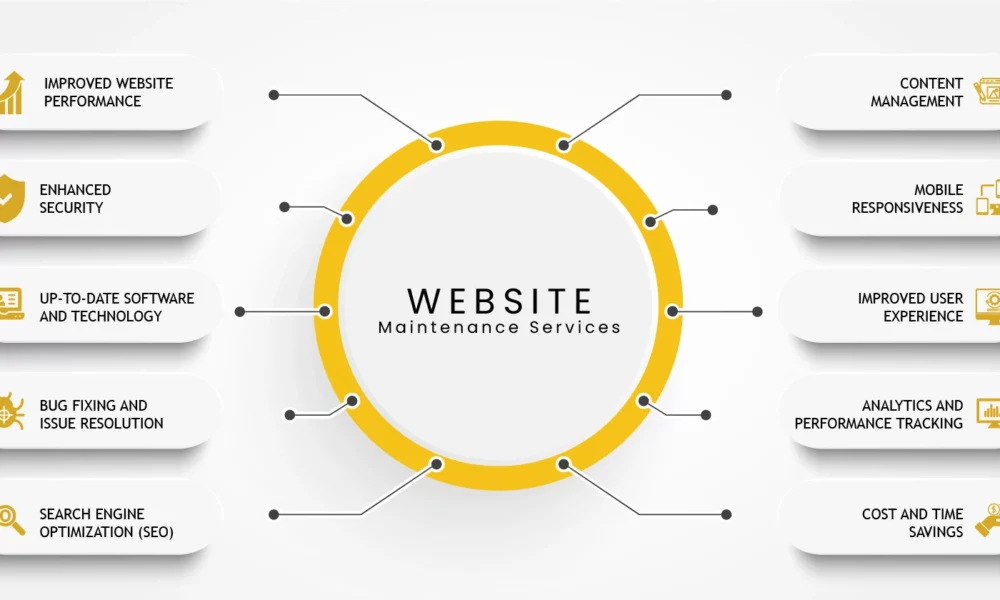Why Regular Maintenance is Key to a Successful Website

Your website is your online storefront, your digital handshake, and often the first impression you make on potential customers. But here’s the kicker—just having a website isn’t enough. Like a car that needs regular oil changes or a garden that thrives with routine care, your website also requires consistent attention to stay relevant, functional, and competitive in today’s fast-paced digital world.
To truly maintain your website effectively, it’s not just about avoiding broken links or outdated plugins—it’s about setting yourself up for long-term success. Let’s explore why website maintenance is crucial and how it can make or break your online presence.
1. Why Maintaining Your Website Is Essential for SEO Success
Search engines, especially Google, love websites that are well-maintained and up-to-date. Regular maintenance ensures that your site runs smoothly, loads quickly, and provides a seamless user experience—all of which are critical for ranking higher on search engine results pages (SERPs).
Here’s how maintenance impacts SEO:
- Faster Load Times: A slow-loading website is a turnoff for visitors and search engines alike. Regular checks ensure your site performs optimally and isn’t weighed down by unnecessary code or large files.
- Elimination of Broken Links: Search engines penalize websites with broken links because they hinder the user experience. Maintenance ensures all links are functional and redirect correctly.
- Updated Content: Fresh, relevant content signals to search engines that your website is active and valuable, improving your SEO rankings.
If you want to remain competitive, managing your website effectively is the first step. It’s not just about impressing search engines; it’s also about keeping your audience engaged.
2. The Role of Security in Website Maintenance
Website security isn’t just a “nice-to-have” feature—it’s non-negotiable. Cyberattacks, malware, and data breaches are becoming more sophisticated, and an outdated website is an easy target.
When you regularly maintain your website, you can:
- Install Security Updates: Platforms like WordPress and other CMS platforms frequently release updates to patch vulnerabilities. Regular maintenance ensures you stay protected.
- Monitor User Access: Keeping track of who has access to your website prevents unauthorized users from compromising your data.
- Back Up Data: A solid maintenance routine includes backing up your website so you can recover quickly in case of a breach or crash.
Remember, a secure website builds trust with your audience. Whether it’s a small blog or an eCommerce site, taking security seriously protects your reputation and your visitors’ sensitive information.
3. Enhancing User Experience Through Maintenance
Your website’s user experience (UX) plays a massive role in retaining visitors and converting them into customers. Imagine landing on a website only to find broken images, outdated designs, or features that don’t work—frustrating, right?
Regular website maintenance allows you to:
- Optimize Navigation: Ensure menus and links are intuitive and easy to follow.
- Fix Bugs: Address glitches or errors that could disrupt the user experience.
- Improve Mobile Responsiveness: With more users browsing on their phones, keeping your site mobile-friendly is essential.
A smooth, user-friendly website keeps visitors engaged and encourages them to explore further, boosting your chances of conversions and sales.
4. Keep Up with Technology and Design Trends
The digital world evolves quickly, and so do user expectations. A website that looked cutting-edge five years ago may now feel outdated compared to competitors.
Website maintenance helps you:
- Incorporate New Features: Whether it’s integrating chatbots, adding video backgrounds, or implementing AI-driven search, staying updated ensures your site meets modern standards.
- Refresh Design: Regular updates allow you to tweak your website’s design to align with current trends and branding strategies.
- Ensure Browser Compatibility: Web browsers like Chrome, Firefox, and Safari regularly update their systems, and your website needs to adapt to these changes.
Staying technologically relevant is a surefire way to show your audience that you’re committed to innovation and quality.
5. Boosting Website Performance
A lagging website can drive visitors away faster than you can say “refresh.” Performance issues like slow loading speeds, unresponsive pages, or incomplete transactions can frustrate users and cost you valuable leads.
By consistently maintaining your website, you can:
- Remove Redundant Files: Clearing old files, images, and backups can free up space and improve site speed.
- Optimize Database: Regular database optimization ensures smoother performance and faster response times.
- Check Third-Party Integrations: Make sure your plugins, APIs, and other tools are updated and functioning properly.
Managing your WordPress website or any other platform involves these routine checks to keep performance top-notch, ensuring that visitors have a seamless experience every time they visit.
6. Protecting Your Brand’s Reputation
Your website is often the first touchpoint for your brand, and a poorly maintained site can tarnish your reputation. Think about it—would you trust a company with a broken or outdated website?
Here’s how regular maintenance protects your brand:
- Ensures Professionalism: A polished, up-to-date site reflects your commitment to quality.
- Prevents Downtime: Regular checks minimize the risk of your website crashing during critical times.
- Keeps Content Relevant: Updating your blog, products, and services keeps your audience informed and engaged.
Your website is an extension of your brand. Investing in its upkeep ensures you always put your best foot forward.
7. Why Active Maintenance for eCommerce Websites is Crucial
For eCommerce businesses, website maintenance is even more critical. Your site isn’t just a marketing tool—it’s your sales platform. Any downtime or glitches can directly impact your revenue.
Key maintenance tasks for eCommerce sites include:
- Updating Product Pages: Keep your inventory, descriptions, and prices accurate.
- Securing Payment Gateways: Regularly test your checkout process to ensure safe, smooth transactions.
- Monitoring Performance: Analyze traffic and sales data to identify and resolve bottlenecks.
Active maintenance for eCommerce websites ensures that your customers enjoy a seamless shopping experience, building trust and encouraging repeat business.
Final Thoughts
Maintaining your website is an ongoing commitment, not a one-time task. Regular updates, security checks, and performance optimizations aren’t just technicalities—they’re essential steps in staying competitive and relevant in the digital age.
Whether you’re managing your WordPress website, running an online store, or simply maintaining a personal blog, consistent care pays off in the long run.
Don’t let your website become outdated or vulnerable. Make maintenance a priority today to secure a stronger tomorrow for your online presence.





